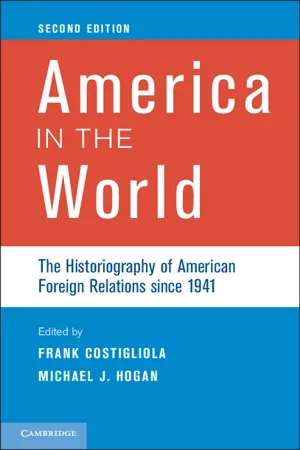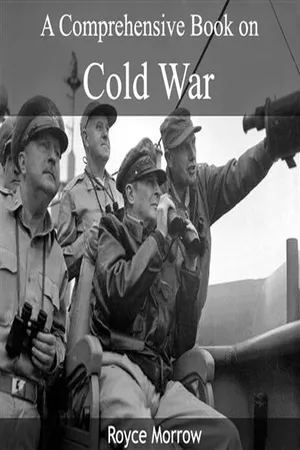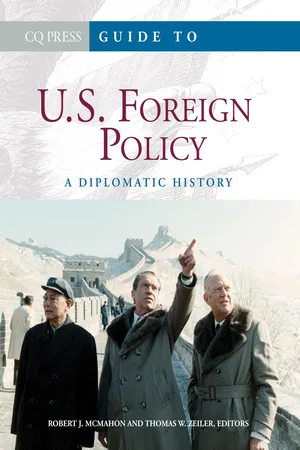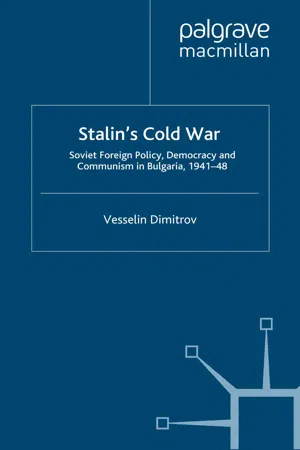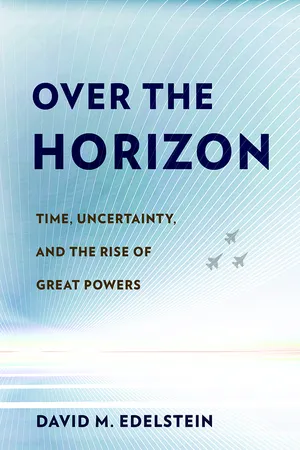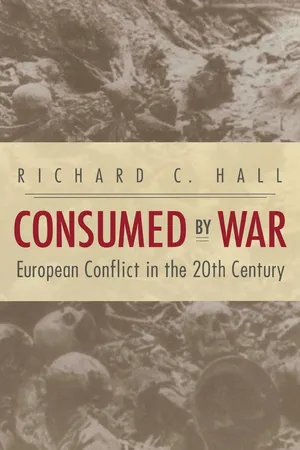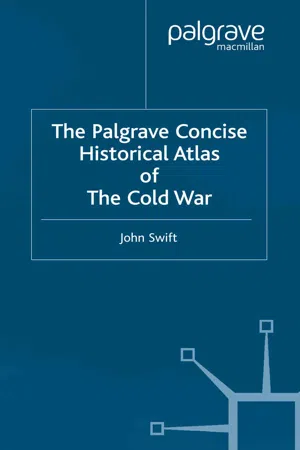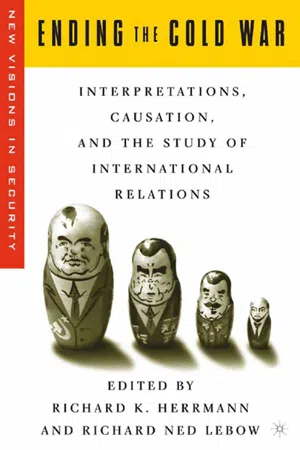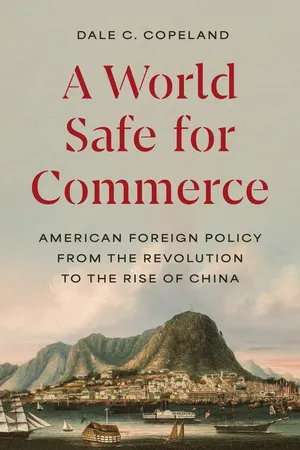History
The Origins of the Cold War
The origins of the Cold War can be traced back to the aftermath of World War II, as tensions between the United States and the Soviet Union escalated due to ideological differences and competition for global influence. This led to a period of political and military rivalry, characterized by proxy wars, espionage, and the development of nuclear weapons, which defined international relations for much of the 20th century.
Written by Perlego with AI-assistance
Related key terms
1 of 5
11 Key excerpts on "The Origins of the Cold War"
- eBook - PDF
America in the World
The Historiography of American Foreign Relations since 1941
- Frank Costigliola, Michael J. Hogan(Authors)
- 2013(Publication Date)
- Cambridge University Press(Publisher)
105 The Cold War came to an abrupt and rather surprising end in 1991, at least considering what might have been. In the twenty years henceforth, the historiography of the conflict has grown immensely, shedding new light on all aspects of the Cold War. The opening of former communist bloc archives, those of other nations that were inescapably drawn into the superpower struggle, and the continued wealth of access to American and Western European sources have made this growth possible. In addi- tion, the “cultural turn” in historical studies of the last two decades has broadened the array of topics that historians consider under Cold War history. This essay highlights some of the trends and work on the his- tory of the Cold War since roughly 1995 with primary emphasis on rela- tions between the war’s two main antagonists – the United States and the Soviet Union. Though necessarily not inclusive of all of the works on the Cold War, it strives to provide an overview that will aid future research. Origins of the Cold War: 1945–1953 The first phase of Cold War historiography was characterized by heated debate between “orthodox” historians, 1 who laid blame for the Cold War almost entirely at the feet of Stalin and the Soviet Union, and “revisionist” historians, 2 who contended that the Cold War was largely the responsibil- ity of the United States. The result was one of the most contentious histo- riographical clashes in U.S. history. 3 Over the ensuing decades historians put forth innumerable works and various interpretations – among them postrevisionism, 4 national security, 5 corporatism, 6 and world-systems analysis 7 – in an effort to move beyond the orthodox-revisionist divide 6 The Cold War Curt Cardwell Curt Cardwell 106 concerning The Origins of the Cold War. However, despite the increased knowledge of the Cold War that this scholarship produced, no satis- factory overarching synthesis ever emerged. - No longer available |Learn more
- (Author)
- 2014(Publication Date)
- College Publishing House(Publisher)
______________________________ WORLD TECHNOLOGIES ______________________________ Chapter 2 Origins of the Cold War The Origins of the Cold War are widely regarded to lie most directly within the relations between the Soviet Union and its World War II allies the United States, Britain and France in the years 1945–1947. Those events led to the Cold War that endured for just under half a century. Events preceding the Second World War, and even the Russian Revolution of 1917, underlay pre-World War II tensions between the Soviet Union, western European countries and the United States. A series of events during and after World War II exacerbated tensions, including the Soviet-German pact during the first two years of the war leading to subsequent invasions, the perceived delay of an amphibious invasion of German-occupied western Europe, the western allies' support of the Atlantic Charter, disagreement in wartime conferences over the fate of Eastern Europe, the Soviets' creation of an Eastern Bloc of Soviet Socialist Republics and Soviet satellite states, western allies scrapping the Morgenthau Plan to support the rebuilding of German industry and the Marshall Plan. Tsarist Russia and the West Differences between the political and economic systems of Russia and the West predated the Russian Revolution of 1917. From the neo-Marxist World Systems perspective, Russia differed from the West as a result of its late integration into the capitalist world economy in the 19th century. Struggling to catch up with the industrialized West as of the late 19th century, Russia upon the revolution in 1917 was essentially a semi-peripheral or peripheral state whose internal balance of forces, tipped by the domination of the Russian industrial sector by foreign capital, had been such that it suffered a decline in its relative diplomatic power internationally. - No longer available |Learn more
- (Author)
- 2014(Publication Date)
- Learning Press(Publisher)
______________________________ WORLD TECHNOLOGIES ______________________________ Chapter- 2 Origins of the Cold War The Origins of the Cold War are widely regarded to lie most directly within the relations between the Soviet Union and its World War II allies the United States, Britain and France in the years 1945–1947. Those events led to the Cold War that endured for just under half a century. Events preceding the Second World War, and even the Russian Revolution of 1917, underlay pre-World War II tensions between the Soviet Union, western European countries and the United States. A series of events during and after World War II exacerbated tensions, including the Soviet-German pact during the first two years of the war leading to subsequent invasions, the perceived delay of an amphibious invasion of German-occupied western Europe, the western allies' support of the Atlantic Charter, disagreement in wartime conferences over the fate of Eastern Europe, the Soviets' creation of an Eastern Bloc of Soviet Socialist Republics and Soviet satellite states, western allies scrapping the Morgenthau Plan to support the rebuilding of German industry and the Marshall Plan. Tsarist Russia and the West Differences between the political and economic systems of Russia and the West predated the Russian Revolution of 1917. From the neo-Marxist World Systems perspective, Russia differed from the West as a result of its late integration into the capitalist world economy in the 19th century. Struggling to catch up with the industrialized West as of the late 19th century, Russia upon the revolution in 1917 was essentially a semi-peripheral or peripheral state whose internal balance of forces, tipped by the domination of the Russian industrial sector by foreign capital, had been such that it suffered a decline in its relative diplomatic power internationally. - eBook - PDF
Guide to U.S. Foreign Policy
A Diplomatic History
- Robert J. McMahon, Thomas W. Zeiler, Robert J. McMahon, Thomas W. Zeiler(Authors)
- 2012(Publication Date)
- CQ Press(Publisher)
At first, U.S. leaders concentrated on the risk of Communist expansion in Europe, which both Washington and Moscow considered pivotal to their long-term interests. This relatively limited conception of the threat gave way after 1949 to fears that the communists were seeking to expand virtually every-where around the world. Cold War tensions peaked in the early 1950s and then again in the early 1960s, when anxiety about nuclear war reverberated through American society. Thereafter, U.S. leaders sought to lessen dangers through negotiation, a trend that culminated in the early 1970s in the era of U.S.-Soviet détente. The Cold War certainly did not end at that point, but it changed in significant ways, not least because the major powers acknowledged mutual interests and accepted the inviolability of each other’s core interests. ORIGINS OF THE COLD WAR, 1945–1949 The United States and the Soviet Union formed a potent alliance during World War II. American industrial prowess combined with the tenacity of the Soviet army to grind down the Nazi military. When Germany surrendered in May 1945, the two countries, thrust into positions of global lead-ership by the drastic weakening of all the other world pow-ers, pledged cooperation to build a durable peace. Within a few months, however, the alliance had crumbled, and by the end of 1947, the two countries had settled into acrimonious rivalry that American newspaper columnist Walter Lippmann dubbed a “cold war.” 1 The confrontation resulted from numerous sources of tension. The two nations had regarded each other warily ever since the 1917 Bolshevik revolution brought communists to power in Russia and established a national ideology diametrically opposed to the American creed of free enterprise and democracy. - eBook - PDF
- John Lukacs(Author)
- 2010(Publication Date)
- Yale University Press(Publisher)
161 S E V E N The Second World War and The Origins of the Cold War Many people, including political ‘‘scientists’’ and historians, have seen and still see the ‘‘cold war’’ as a consequence of World Communism. In the United States leading ‘‘conservatives,’’ James Burnham and William Buckley, wrote that in 1917 ‘‘history changed gears.’’ In Germany, Ernst Nolte, a historian, wrote that beginning in 1917, with the Communist revolution in Russia, the entire history of the twentieth century thereafter was that of a ‘‘European civil war.’’ This is—they are—wrong. The ‘‘cold war’’ was a consequence of the Second World War. Its cause was the nature of the Russian occupation of most of Eastern Europe and of eastern Germany. The words cold war came into existence in the United States in 1948. We may pin down the chronological limits of the ‘‘war’’: 1947 to 1989. In 1947 Russian and Commu-nist rule in the eastern portion of Europe became, by and large, 162 The Origins of the Cold War unconditional; in 1989 the Communist governments in Eastern Europe ceased to exist. True, the first reactions of the American government against further Communist or Russian expansion and against the aggressiveness of the Russian government began to appear a year before 1947, and the ending of hostility between the American and Russian governments about two years before 1989, and the final end of Communism and the dissolution of the Soviet Union in 1991: still, it is proper and reasonable to fix the frame, the duration of the cold war, from 1947 to 1989. - eBook - PDF
Stalin's Cold War
Soviet Foreign Policy, Democracy and Communism in Bulgaria, 1941-48
- V. Dimitrov(Author)
- 2007(Publication Date)
- Palgrave Macmillan(Publisher)
Introduction: Casting a New Look at The Origins of the Cold War The failure of the Soviet Union, the United States and Great Britain to reach an agreement on the domestic institutions and international sta- tus of the countries of Eastern Europe following the Second World War was a primary cause of the breakdown of their wartime alliance and the onset of the Cold War. It was the Soviet suppression of democracy in Eastern Europe and the absorption of the Eastern European states into a Soviet-dominated bloc that convinced American and British policy- makers of Moscow’s expansionist ambitions and of the basic incompati- bility between liberal democracy and communism. On the Soviet side, Eastern Europe was seen as a vital zone of influence and an area in which the local communists could be expected to play a leading role in the postwar reshaping of the political institutions of their countries. Western refusal to recognize the legitimacy of these aspirations was per- ceived in Moscow as an indication of the capitalist world’s aggressive intentions towards the Soviet Union. Eastern Europe thus became a crucible for the conflict that defined most of the second half of the twentieth century. Until 1989–91, how- ever, research on the region was limited by a lack of primary sources on the policy-making of two of the major protagonists, the Soviet Union and the local communist parties. Until the fall of communism, Cold War historiography could study these two actors only indirectly, by analysing the far more plentiful American and British sources, develop- ing interpretations of the policies of the Western powers, and then using these interpretations as a basis for understanding Soviet and communist behaviour. Treatments of American foreign policy have largely set the terms of debate in the Cold War literature. 1 The volume, quality and relatively early release of US sources made it possible to develop a wide range of 1 - eBook - ePub
Over the Horizon
Time, Uncertainty, and the Rise of Great Powers
- David M. Edelstein(Author)
- 2017(Publication Date)
- Cornell University Press(Publisher)
CHAPTER 5The Origins of the Cold War
This chapter examines the dynamics of emerging threats in an environment where other threats were absent. During World War II, the pressing threat of Nazi Germany and imperial Japan produced short time horizons and the mutual benefits of cooperation for the Allied powers. At the end of World War II, time horizons became elongated, and competition resulted. The United States was by any measure the most powerful country in the world after World War II. Given the small short-term rewards for cooperation, the absence of alternative threats, and growing concern about long-term Soviet intentions, the United States transitioned from the cooperation that characterized World War II to the competition that characterized the Cold War. As much as emerging bipolarity set the stage for the Cold War, it was U.S. beliefs about long-term Soviet intentions that explain the timing and emergence of the conflict. While the United States might have preferred to come home after the conclusion of World War II, growing concern about Soviet intentions made that impossible.1 To be clear, U.S. behavior was not blameless in the origins of the conflict, but this chapter aims to provide a better understanding of how the United States came to regard the threat posed by an emerging postwar Soviet Union.This chapter serves a different purpose than the other empirical chapters. It is not surprising that the United States and the Soviet Union found value in a marriage of convenience to defeat Hitler’s Germany. What this case does allow for is a more careful examination of the role that beliefs about intentions, rather than simply capabilities, play in resolving uncertainty about the threat posed by a rising power. While there is no denying that the structural environment of bipolarity after World War II made Soviet-U.S. competition more likely, this chapter demonstrates that it was increasing evidence of Soviet intentions that was the driving force behind the evolution of U.S. strategy toward Moscow. The United States was not overly concerned by the immediate military threat that Moscow posed to Western Europe. In fact, Washington’s inclination was to pull back and come home once the war had concluded. But ominous signals of Soviet intentions added to the weight of the evidence supporting a reasonable probability that the Soviets did, indeed, pose a threat. It was beliefs about intentions and the transformation of uncertainty into risk that generated the Cold War. - eBook - PDF
Consumed by War
European Conflict in the 20th Century
- Richard C. Hall(Author)
- 2014(Publication Date)
- The University Press of Kentucky(Publisher)
Chapter 12 ORIGINS OF THE COLD WAR The origins of the settlement of the Second World War began during the actual fighting. This settlement is inseparable from the beginning of the Cold War, the third phase of the twentieth-century European conflict. The Cold War began as the Second World War concluded and prevented a formal resolution of that war for some time. German war aims were fairly straightforward, though they tending toward the fantastical. The Germans wanted to dominate Europe eco- nomically and politically as far as the Ural Mountains. This involved the defeat of France in western Europe and the conquest of Soviet Russia for the acquisition of lebensraum in eastern Europe. This lebensraum was partly economic, intended to ensure that Germany would never have to endure economic travails because of a British blockage. It was also partly political: Hitler wanted to ensure German domination of Europe for a thousand years. Mussolini sought the realization of a new Roman Empire in the Med- iterranean region. Germany's eastern European subordinates were mainly interested in realizing their national objectives, usually at their neighbors' or one another's expense. Both the Finns and the Romanians wanted to regain and expand territories previously ceded to Soviet Russia. The Allied objectives were more problematic. Britain and France ini- tially went to war to protect Poland, but after the first month of the con- flict, the German-Russian victory over Poland made this goal unrealistic. German successes throughout Europe in 1940 further obscured Allied war aims. For Britain, the sole remaining enemy of German expansion plans, simple survival became paramount in the face of German domina- tion of the European continent. Origins of the Cold War 191 Stalin had two major objectives. One was ideological: he sought to preserve and spread his version of accelerated Marxist Leninism. The other was political: he wanted Soviet power to survive. - J. Swift(Author)
- 2003(Publication Date)
- Palgrave Macmillan(Publisher)
The Origins of the Cold War W here should we seek The Origins of the Cold War? A common misconception is that World War II ended with the United States, the Soviet Union and Britain as close allies, whose relationship only broke down in the following years. In fact the hostility of the west towards the Soviet Union dates back to its foundation. Indeed, a case could be made that this hostility was only an extension of western suspicion of Imperial Russian ambitions, dating back to the nineteenth century. What is unarguable is that from the moment the Bolsheviks seized power, foreign governments sought to bring them down. During World War I, the Russian armies had per- formed creditably, if not spectacularly, in tying down large enemy forces on the eastern front. But the strains of keeping huge forces in the field, keeping them supplied and replacing terrible losses, gave rise to crises Nicholas II was ill suited to address. By March 1917 (or February in the pre-revolutionary calendar) support for the Romanov dynasty had evaporated, and it was swept aside with sur- prising ease. A provisional government was formed, which was intended to pave the way for the foundation of a democratic republic in Russia. But by continuing the war, and proving as incapable of addressing Russia’s needs as the Romanovs, support for the provisional government also evaporated very quickly. Parties of the left had feared counter-revolution – the return of the Romanovs – and threw their support behind the provisional government, and lost their own supporters in consequence. Only the Bolsheviks had been uncompromising in their hostility. Russia, a backward, agrarian nation, was hardly suitable ground for a Communist revolution, but Lenin was con- vinced that revolution was imminent in the west, which would justify an immediate Bolshevik revolution. Also those clamouring for peace, land and bread, no matter what their political opinions, had nowhere else to turn.- eBook - PDF
Ending the Cold War
Interpretations, Causation and the Study of International Relations
- R. Herrmann, R. Lebow, R. Herrmann, R. Lebow(Authors)
- 2004(Publication Date)
- Palgrave Macmillan(Publisher)
By compelling scholars to specify different pathways to war, the Kriegschuldfrage also provided conceptual lenses and analogies that proved use- ful in understanding the Cold War and other conflicts. In sum, the decades- long debate over the origins of World War I, while still unresolved, was an important catalyst for the development both of international relations theory and foreign policy thinking. President Kennedy’s reluctance to carry out an air strike in the Cuban missile crisis derived in large part from his earlier reading of Barbara Tuchman’s The Guns of August and its portrayal of World War I as a case of runaway, mutual escalation. There is every reason to expect that rigor- ous study of the end of the Cold War, based on new empirical evidence, better specification, and even reformulation of existing explanations, their evaluation by means of an in-depth case study, and subsequently, by comparative analysis, will generate the same kinds of theoretical and policy insights into the process of accommodation. Notes 1. Hans Morgenthau, in Politics Among Nations, 4th ed. (New York: Alfred Knopf, 1966), distinguishes between the onset of the Cold War in 1947 and bipolarity, which he does not believe was achieved until the mid-1950s at the earliest. Kenneth N. Waltz, Theory of International Politics (Reading, MA: Addison-Wesley, 1979), and “The Emerging Struc- ture of International Politics,” International Security 18 (Fall 1993), pp. 5–43; John J. Mearsheimer, “Back to the Future: Instability in Europe After the Cold War,” Interna- tional Security 15 (Summer 1990), pp. 5–56; William C. Wohlforth, “Realism and the End of the Cold War,” International Security 19 (Winter 1994–95), pp. 91–129; Kenneth A. Oye, “Explaining the End of the Cold War: Morphological and Behavioral Adapta- tions to the Nuclear Peace?,” in Richard Ned Lebow and Thomas Risse-Kappen, Interna- tional Relations Theory and the End of the Cold War (New York: Columbia University Press, 1995), pp. - eBook - PDF
A World Safe for Commerce
American Foreign Policy from the Revolution to the Rise of China
- Dale C. Copeland(Author)
- 2024(Publication Date)
- Princeton University Press(Publisher)
By securing a strong economic and political Second World War and Cold War 243 position on the periphery, the United States would be able to direct the post- war recovery of most of the globe and keep the Soviets from drawing large parts of it to its side. If the Soviets decided to work with Washington and keep order within their own smaller sphere, great. But if not, then the United States would have the power base needed to deal with anything that arose in the future, and with the problems on the ground in the present. I will be talking about the causes of the Cold War and the way it played out over forty-five years for the next three chapters. Before I proceed, therefore, I need to briefly address what might seem to be a self-evident truth: that eco- nomic interdependence could have had little to do with either the Cold War’s origins or with the crises and tensions that pockmarked its history until the late 1980s. After all, U.S.-Soviet trade from late 1945 onward remained at very low levels given what seemed to be strong geopolitical reasons for not trading, particularly American fears that trade would promote Soviet relative economic growth within the new more zero-sum, bipolar world Washington now faced. It would thus seem that economic interdependence drops out as a causal vari- able that might explain both the start of the Cold War and its dynamics over some four decades. Indeed, both realists and liberals usually completely ignore the economic aspects of the U.S.-Soviet relationship from 1945 to the 1980s, presuming that low or almost nonexistent trade could not possibly have had much of a role in the Cold War struggle.
Index pages curate the most relevant extracts from our library of academic textbooks. They’ve been created using an in-house natural language model (NLM), each adding context and meaning to key research topics.
